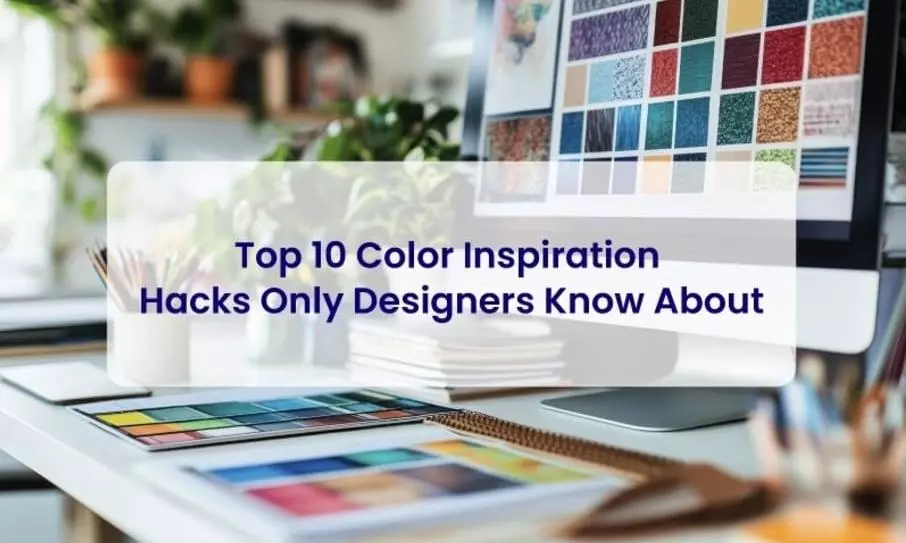Talented designers love to grab ideas from exclusive and creative fields.

Colors are a significant part of any graphic design. The feelings, emotions, and behaviors of human beings are deeply moved and shaped by colors. Businesses leverage bold and vibrant colors to create a visually fascinating identity. The core purpose is to engage the targeted audience and capture their hearts. Graphic designers have a set of hacks to craft stunning color coordination. However, relying on logo creation can make a significant difference in getting the most professional color matching ideas.
10 Color Hacks Designers Use
This blog lists the top 10 color inspiration secrets. These hacks are incorporated by graphic designers to bring their creative ideas into artistic visuals. Let’s find out what these hacks are.
1. Real Life Color Palette Inspirations
The world around us is loaded with stunning color fusions. Different color tones can be found in coffee shop interiors, book covers, street art, and so on. Skilled designers love to get color inspiration from the objects present in their surroundings. They photograph every color combination they like the most. They can directly take inspiration from a captured picture and create fabulous art when designing a picture.
2. Steal Ideas from Creative Fields
Talented designers love to grab ideas from exclusive and creative fields. These fields are arts and crafts, the fashion industry, makeup artists, the film world, interior design, and architecture. Each one of these artistic fields has fascinating color patterns. Graphic designers delve into the colorful world of these disciplines and expertly incorporate these compelling color essences into their image-creation process.
3. Apply Color Psychology
Leveraging color psychology is another superb method that designers rely upon. Human behaviors and emotions are greatly influenced by the colors they like. Therefore, color psychology is widely used by branding and marketing industries to grab the attention of the target consumer. For instance, warm colors like yellow symbolize energy, and cool colors like blue symbolize tranquil vibes. Graphic designers are skilled at blending colors that hit the nerves of spectators.
4. Use Color Wheels
The color wheel is a circular visual diagram that provides fantastic color combination ideas. Color wheels have made the color selection process effortless and simplified for designers. It helps them select from the complementary and analogous color schemes. Graphic designers are skilled at experimenting with different colors to create artistic designs. In this way, they integrate colors that look natural and cohesive with each other.
5. Juxtaposition of Colors
In the graphic design world, it refers to the technique in which designers place two colors, a bright and light color side-by-side in a way to give a contrasting effect. This technique helps to differentiate the background layout and typography style. If both colors are in the brightest tone, it affects the readability of users. That’s why, to enhance the user experience with the graphics, designers use their expertise to create an appealing contrasting tone.
6. Borrow Inspiration from Nature
Divine nature works as a secret color book for graphic designers. Natural imagery is filled with countless color coordination. The living world has fruits, birds, animals, forests, landscapes, and many more breathtaking natural things. Expert creators are greatly inspired by natural color palettes and seamlessly blend into the templates. The designs based on earthy tones not only attract nature admirers but also radiate refreshing vibes.
7. 60-30-10 Rule
It is one of the most commonly used techniques to present a flawless color pattern in graphic designs. In this method, dominant colors are used 60%, secondary colors are used 30%, and accent shades are used 10%. This technique makes it easier for designers to choose colors that fabulously match each other and give a vibrant or aesthetic effect. Moreover, being limited to a few colors is the best way to maintain the visual appearance of the entire design.
8. Cultural Effects of Hues
Different parts of the world have associated different meanings with each color. For instance, in some places, red is associated with luck. In some regions, it represents warning and danger. Japanese artists use soft colors in paintings. So, different colors have different meanings in the world. Therefore, graphic designers take inspiration from other cultures. It helps them to create designs that fabulously resonate with the traditions of users.
9. Follow Seasonal Color Trends
Expert graphic designers incorporate colors similar to seasons to create natural imagery. Each season is identified with its own magnificent and appealing color palette. For instance, spring has a soft and fresh color. Summer has bright and energetic color fusions. Winter has icy whites and icy blue color schemes. The Autumn season has earthy brown and subtle tones. Therefore, designers keep an eye on seasonal color trends to create an aesthetic and natural effect.
10. Online Color Palette Generators
Several online color tone tools are available for free. Some of these are Logocreation, Canva, Adobe Color, Color Hunt, Khorma, and so on. These color tone-generating tools have a user-friendly interface and an easy color selection process. Graphic designers rely on these online tools to craft a captivating color scheme. They give color ideas without much nuisance and save time.
Conclusion
These top ten color hacks open the door to the creative world of proficient graphic designers. From taking inspiration from real-life objects to using online color palette tools, each hack speaks volumes about designers' artistic qualities
